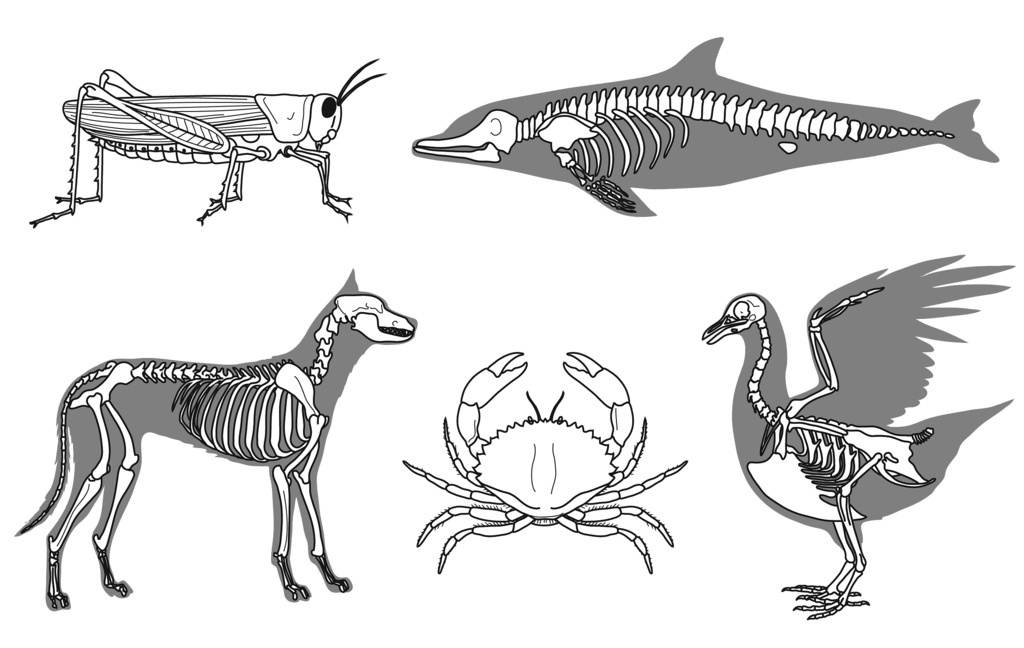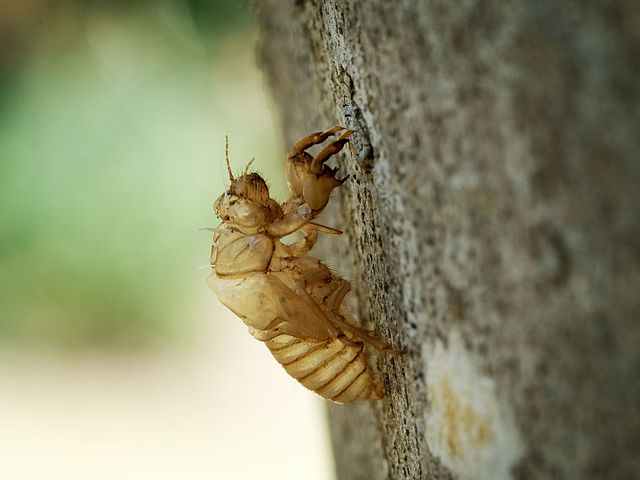Difference between Endoskeleton and Exoskeleton
What is Endoskeleton?
Definition of Endoskeleton:
An endoskeleton is a skeleton that is found on the inside of the body of an animal.
Development of Endoskeleton:
The endoskeleton of chordates develops from mesodermal tissue during embryonic development. The vertebrate endoskeleton develops into cartilage and bone.

Support and movement:
The bony skeleton has allowed vertebrate animals to grow large in size, since it provides enough support to hold considerable weight. An endoskeleton enables movement by providing bony surfaces for muscle attachment. In vertebrates, skeletal muscles attach to bones by tendons.
Protection:
An endoskeleton of bone protects animals from predators by enabling muscle attachment. This means that a vertebrate animal can flee from predators by movement. In the case of birds, this means flight. Bird’s bones are modified by being hollow, which allows the birds to be light enough to fly away from predators. A bony endoskeleton provides good protection for internal organs. For instance the rib cage is a strong structure that protects the heart and lungs.
Repair and replacement:
Bones that break take a long time to heal. Repair starts with the chondrocytes, which are cells that produce cartilage. Later these are replaced by osteocytes which produce bone tissue. Bones also weaken as a vertebrate animal ages, leading to reduced height and mobility.
Blood supply:
Bones contain a blood supply so if a person breaks large bones such as the pelvic bones, they can lose large amounts of blood.
Animal examples for Endoskeleton:
An endoskeleton occurs in chordates (including all the vertebrates). The vertebrate endoskeleton is made of cartilage and bone tissue.

What is Exoskeleton?
Definition of Exoskeleton:
An exoskeleton is a skeleton that develops on the outside of the body of an animal.
Development of Exoskeleton:
The exoskeleton of invertebrates is formed from various proteins, carbohydrates or minerals. The arthropod exoskeleton develops when chitin is deposited and combined with protein. Molluscan exoskeletons consist of calcium carbonate shells that the animal deposits.
Support and movement:
The exoskeleton provides support for all the internal organs and tissues of the animal. It is also often flexible since it is not as solid as an endoskeleton. However, the exoskeleton places a limitation on how large an animal can grow. The exoskeleton is often flexible and light in weight which enables animals to easily move. In the case of arthropods there are joints where soft membranous material is present to enable the animal to flex the appendages.
Protection:
Exoskeletons do not provide as much protection from strong physical forces the way that endoskeletons do, except in the case of a shell. An exoskeleton can be modified for protection from predators. For instance, an insect can develop spikes, or colors in the exoskeleton that allow it to be physically protected or camouflaged.
Repair and replacement:
The exoskeleton can usually be easily replaced since the animal molts, during which time it sheds the old exoskeleton and deposits a new one. In the case of shells, new layers can be deposited.
Animal examples for Exoskeleton:
Arthropods, crustaceans and molluscs all have an exoskeleton. The minerals making up the exoskeleton can vary among different animals, with insects and crustaceans having chitin present, and molluscs having calcium carbonate present.
Difference between Endoskeleton and Exoskeleton
-
Location of Endoskeleton and Exoskeleton
An endoskeleton is located on the inside of the body of an animal while an exoskeleton is located on the outside of the body of an animal.
-
Development of Endoskeleton and Exoskeleton
In vertebrate animals with an endoskeleton, cartilage and bone is deposited. In invertebrates such as arthropods chitin and protein is deposited, while in some molluscs, a calcium carbonate shell is deposited.
-
Support and body size of Endoskeleton and Exoskeleton
An endoskeleton can support a large body size but an exoskeleton cannot support a large body size.
-
Movement of Endoskeleton and Exoskeleton
An endoskeleton enables movement by muscles pulling on bones, while an exoskeleton enables movement by having membranous joints between appendages.
-
Protection from predators
Animals with an endoskeleton are protected from predators by moving away using muscles that are joined to their bones, while animals with an exoskeleton are protected from predators by having exoskeleton modifications such as spines or camouflage colors.
-
Protection from physical forces
An endoskeleton is usually stronger and provides more protection from physical forces than an exoskeleton.
-
Repair and replacement
Vertebrate endoskeleton takes a long time to heal with cartilage and then bone being deposited. An exoskeleton can be replaced quite quickly with chitin and protein, or calcium carbonate being deposited.
-
Blood supply of Endoskeleton and Exoskeleton
An endoskeleton contains a blood supply, but this is not the case with an exoskeleton.
-
Animal examples
An endoskeleton is found in chordates such as vertebrates while an exoskeleton is found in arthropods and some molluscs.
Table comparing Endoskeleton and Exoskeleton

Summary of Endoskeleton Vs. Exoskeleton
- An endoskeleton is formed on the inside of an animal’s body, while an exoskeleton is formed on the outside of an animal’s body.
- An endoskeleton is often made of cartilage and bone, while an exoskeleton is often made of chitin and proteins, or calcium carbonate.
- An endoskeleton can support a large body size and is often made of bone.
- An exoskeleton cannot support a large body size and is often made of chitin or minerals.
- An endoskeleton and exoskeleton provide support and protection to animals.
- Difference Between Rumination and Regurgitation - June 13, 2024
- Difference Between Pyelectasis and Hydronephrosis - June 4, 2024
- Difference Between Cellulitis and Erysipelas - June 1, 2024
Search DifferenceBetween.net :
1 Comment
Leave a Response
References :
[0]Dorit, Robert L, Warren F. Walker, and Robert D. Barnes. Zoology. Philadelphia: Saunders College Publishing, 1991. Print.
[1]Encyclopedia Britannica. “Vertebrate”. Animal. Encyclopedia Britannica, 2018, https://www.britannica.com/animal/vertebrate
[2]Kilgour, O.F.G. Mastering Biology. London: MacMillan Press, 1982. Print.
[3]Image credit: https://c1.staticflickr.com/3/2904/13578810393_0c6ecc4fc1_b.jpg
[4]Image credit: https://upload.wikimedia.org/wikipedia/commons/thumb/3/3e/Exoskeleton_Cicada_2015_Spoleto.jpg/640px-Exoskeleton_Cicada_2015_Spoleto.jpg

Hi mam i am Sheheryar from Pakistan. I want to get p.hd degree in Zoology also can you help me????